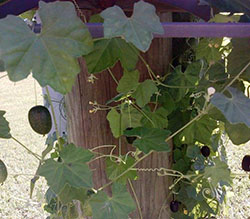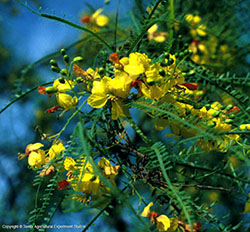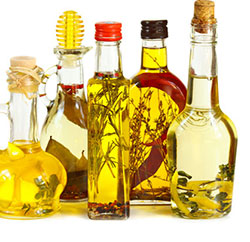A: I believe it is a native annual called Creeping cucumber, Melothria pendula, which is in the cucumber family. The leaves are heart-shaped and lobed and have a sand paper feel. The flowers are yellow. I am always reluctant to tell anyone they can eat something in the wild we all react differently to various plant parts. The fruit is a green or black berry with white seeds and while the fruit is edible it can be a strong laxative. Most people classify creeping cucumber as a weed and it can become a nuisance because it creates seeds in large numbers. The fruit is small and it often causes digestive problems therefore creeping cucumber is seldom considered useful for vegetable gardens.
Monthly Archives: October 2014
Q: What is this tree? It is planted outside my bank and I have never seen anything like it. It has yellow flowers and tiny thorns. I really want one for my yard
A: I believe it is a Jerusalem-Thorn tree, Parkinsonia aculeata. It is a small, deciduous landscape tree with delicate, tiny leaves. At maturity it has been known to grow 15-29 feet tall and spread about 20-25 feet. Jerusalem-Thorn thrives in full sun, tolerates most any type of soil; it is highly drought and salt tolerant. In spite of its rapid growth rate, it has strong wood, withstanding harsh winds with ease due to the open growth habit. However, the trees have a short life span, commonly living only 15 to 20 years. Poor drainage may account for short life on many sites, so locate it accordingly in areas where soil is never wet for more than an hour or two. The bark is thin and easily injured and the tree appears to compartmentalize decay poorly – so keep the weed-eaters as far away as possible. Locate the tree properly and design the site to minimize trunk injury which generally requires keeping lawn grass far away from the base of the tree. You may have some difficulty locating the tree if you want to plant one in your yard but a reputable nursery should be able to find you a suitable specimen. For more complete information check out the University of Florida publication: http://edis.ifas.ufl.edu/st431
Q: I want to add fresh and dried herbs to oil. I have been told there might be a food safety issue if I do this on my own. Please help.
A: Since you were asking me a food safety question, I deferred to Meg McAlpine our Family Consumer Science agent who provided information from Oregon State University and Colorado State University. Basically, garlic, vegetables or herbs in an oil mixture may support the growth of Clostridium botulinum bacteria. For safety reasons, these oils should be made fresh. Leftovers must be refrigerated and used within three days, then discarded. Herbed oils are made commercially but some form of acid must be added to the process to ensure safety. You can make flavored vinegars using garlic, vegetables or herbs as the acid in the vinegar will not allow the growth of Clostridium botulinum bacteria. However, it is possible for some of the vinegars to support the growth of Escherichia coli bacteria. Either infused oils or vinegars can cause great harm if not made and stored properly because of the potential for harboring these deadly bacteria. The following publications will provide more information to avoid contamination: http://extension.oregonstate.edu/fch/sites/default/files/documents/sp_50_701_herbsandvegetablesinoil.pdf



